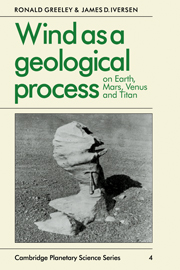Book contents
- Frontmatter
- Contents
- Preface
- 1 Wind as a geological process
- 2 The aeolian environment
- 3 Physics of particle motion
- 4 Aeolian abrasion and erosion
- 5 Aeolian sand deposits and bedforms
- 6 Interaction of wind and topography
- 7 Windblown dust
- Appendix A Nomenclature and symbols
- Appendix B Small-scale modeling of aeolian phenomena in the wind tunnel
- Glossary
- References
- Index
3 - Physics of particle motion
Published online by Cambridge University Press: 16 November 2009
- Frontmatter
- Contents
- Preface
- 1 Wind as a geological process
- 2 The aeolian environment
- 3 Physics of particle motion
- 4 Aeolian abrasion and erosion
- 5 Aeolian sand deposits and bedforms
- 6 Interaction of wind and topography
- 7 Windblown dust
- Appendix A Nomenclature and symbols
- Appendix B Small-scale modeling of aeolian phenomena in the wind tunnel
- Glossary
- References
- Index
Summary
Introduction
Many images of Mars show sand dunes and wind-related surface features that are clear evidence of atmospheric processes. These remarkable pictures have sparked new interest in understanding the complex phenomena associated with windblown particles, which in turn has led to increased knowledge and understanding of aeolian processes on Earth. In this chapter we discuss some of the basic physics of particle motion, particularly in regard to the effects of widely different atmospheric densities on the terrestrial planets. Most of these phenomena, such as the characteristics which determine onset of motion and the transport rate of material in motion, are not yet completely understood because of their physical complexity and the difficulty of observation.
Much of the early research on the basic physics of windblown sand was performed by R. A. Bagnold. As an officer in the British Army, he led expeditions across the sand seas of Egypt in the 1930s. His observations provided the foundation for understanding sand motion and the formation of sand dunes and ripples. Later, in England, he built a wind tunnel in order to make quantitative measurements of threshold wind speeds and mass transport rates. His findings are reported in his delightfully lucid cornerstone book (Bagnold, 1941) and in many papers.
A parallel effort on the problems of soil erosion has been carried out by the US Department of Agriculture at a wind tunnel laboratory in Manhattan, Kansas. Most of the understanding of the physics of soil movement by wind, especially as related to agricultural applications, was derived by W. S. Chepil who reported his work in a large number of papers during a 25-year period beginning about 1940.
- Type
- Chapter
- Information
- Wind as a Geological ProcessOn Earth, Mars, Venus and Titan, pp. 67 - 107Publisher: Cambridge University PressPrint publication year: 1985
- 4
- Cited by



